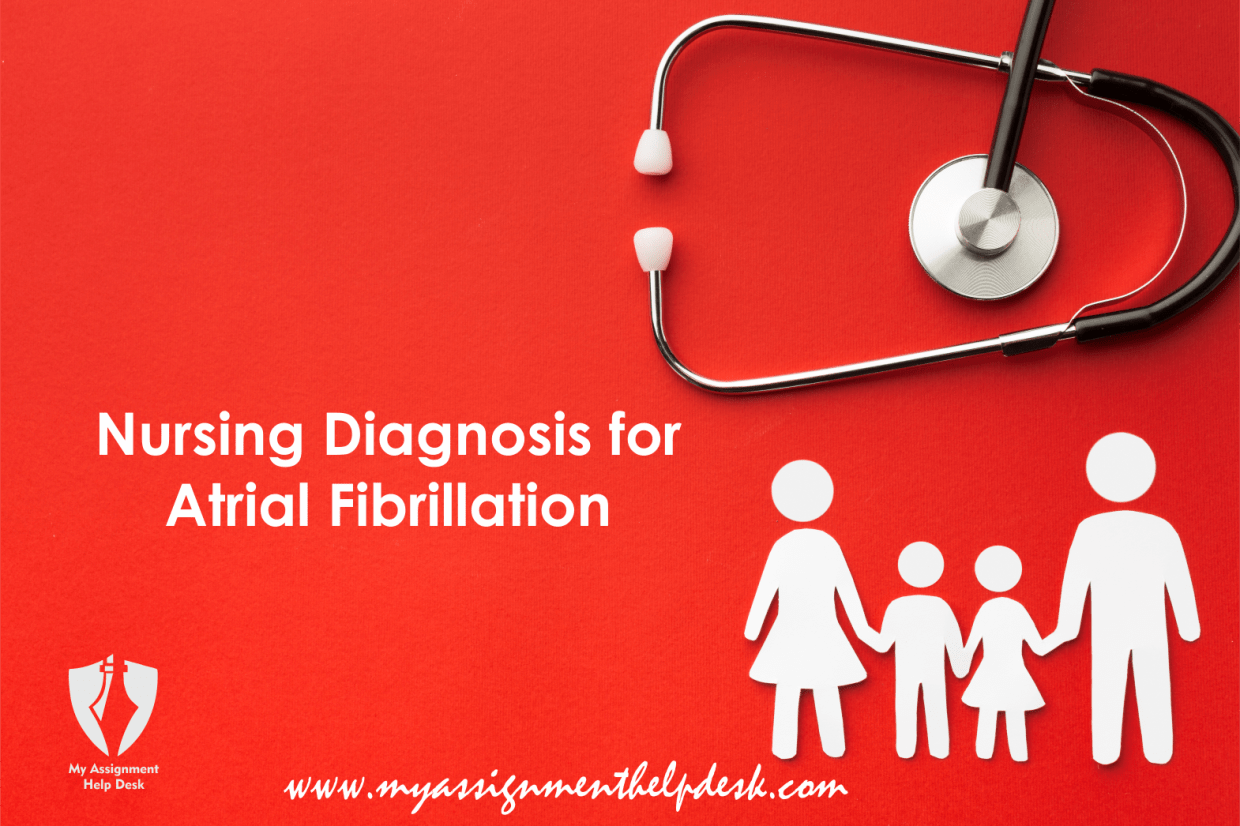Nursing Diagnosis for Atrial Fibrillation
Cardiac problems are on the rise due to our lifestyles and eating habits. One such problem of the heart is atrial fibrillation (AF), which occurs as an irregular but rapid heart rate that occurs due to the chaotic electrical signal that is experienced in the upper chambers. When this happens, one experiences a fast but irregular heart rhythm. The heart rate in atrial fibrillation is between 100 and 175 beats per minute, whiles the normal range is 60-100 beats per minute.
Atrial fibrillation is a severe condition that affects about 1.7% of the population. It is also more familiar with the aged population- 10% of those aged above 75 years of age. AF is diagnosed with patients who present debilitating symptoms but in most cases, it may be unnoticed and untreated. You’ll find this article helpful as it will guide you through the nursing diagnosis for AF.
Table of Contents
What are the different Classes of Atrial Fibrillation
Depending on the encounters of the AF, the duration of experience, and other features, AF is classified into five categories:
- The first diagnosis- this encompasses all the patients that present the AF for the first time in their life.
- Paroxysmal- this is a self-terminating AF that commonly ends within seven days.
- Persistent AF- these are the AF episodes that last for more than seven days but can self-terminate after pharmacological intervention.
- Long-standing persistent- this is the condition that persists for more than one year before the right rhythm is adopted.
- Permanent- the AF exists when the arrhythmia is accepted permanently by the patients, and the physicians agree.
The different classes of the AF require varying intervention measures, which is primarily defined by the response by the patient to varying treatments.
What are the signs and Symptoms of AF?
Some patients may not show any signs of AF and may even be unaware of the conditions until a physical examination is conducted. As a nurse, you need to understand some of the symptoms that may prompt you to refer for examination. First, the condition is exhibited through palpitations that may create a sensation and discomfort in the chest. The patient may exhibit an irregular heartbeat.
Due to the irregular heartbeat that could be rapid, the patient may demonstrate body weaknesses, reduced ability to doing exercise, fatigue, and lightheadedness. The patient could also suffer from dizziness and shortness of breath. Chest pain could also be experienced.
Desired Diagnosis Outcome
When diagnosing the patient with AF, the guiding principle is to improve the heart’s rhythm and promote a healthy heart rate. In this case, the nurse, as directed by the physician, should help in resetting the heart rhythm to normal by ensuring the intake of the medication. Secondly, it is expected that after the diagnosis, the heart rate should be controlled. This plays a role in the restoration of the heart’s normal rate.
The nurse should also ensure that there are no complications that are recorded. Concerning this, a common complication is the formation of blood clots that may be lethal. Due to the risk that is posed by clot formation, the nurse, through the diagnosis process, should help to prevent that from happening. Furthermore, the diagnosis process should help to relieve some of the symptoms that come with AF, such as fatigue and body weakness.
Nursing Diagnosis of AF
In the diagnosis of AF, the nurse may review the patient for some signs and symptoms, do a medical history, and conduct a physical examination of the person.
Health History
The nurse should conduct a review of the health history of the patient to establish the risk level. Some of the health conditions act to expose the patient to a greater risk of AF. For instance, the nurse conducts a history review to establish cases of anaemia, shortness of breath, and blood pressure.
The condition poses a more significant risk for patients who have experienced heart diseases such as heart valve complications, heart failures, and coronary artery problems. Patients with high blood pressure are also at high risk of being affected by AF.
Other chronic problems that the nurse should seek to establish from the patient include cases of thyroid problems, sleep apnea, and diabetes, kidney, or lung problems.
Physical Examination
The patient should be carefully examined to determine if there is an exhibition of the notable signs and symptoms that need to be addressed. Physical examination also helps to determine the mode of intervention by the nurse. First, the nurse examines the breathing pattern of the patient- instances of shortness of breath could indicate respiratory problems arising from the AF.
The patient should be examined on the cardiac performance to determine the severity of the case- this is done to determine the heart rhythm. This should be done continually throughout the intervention period.
The nurse should also conduct a stress test through a running test to know the condition of the heart. Other physical tests include chest X-rays that help to indicate the condition of the lungs.
Most important Diagnosis Tests
In instances when the nurse may establish that further examination and testing are necessary, he/she may make such a request to determine the intervention method. Some of the tests that can be conducted include:
- Electrocardiogram (ECG). Electrodes are attached to the chest and arm to send and record signals of the heart condition. This is the primary diagnostic tool for AF.
- Holter monitor. A portable ECG device may be worn and put on the shoulder strap that may record the heart activity within about 24 hours. It gives the heart rhythms. This is a powerful nursing diagnosis tool for AF as it helps to monitor the patient.
- Event Recorder. ECG devices that have the potential of monitoring heart activity when the symptoms are manifesting. The ECG device is put on the body, and the patient pushes it to record when needed.
- This test uses a sound wave for the creation of image representation of the heart. It is commonly needed to diagnosis the structure of the heart and sees blood clots in the heart.
Some of the diagnostic tests may require specialized person but are required by the nurse for monitoring of the patient’s recovery.
References
- Ackley, B. J., & Ladwig, G. B. (2010). Nursing Diagnosis Handbook-E-Book: An Evidence-Based Guide to Planning Care. Elsevier Health Sciences.
- Cecilia Gutierrez, Md, And Daniel G. Blanchard, MD, (2016). Diagnosis and Treatment of Atrial Fibrillation. University of California, San Diego, Am Fam Physician.2016 Sep 15;94(6):442-452.
- Registered Nurse RN.com Nursing Care Plan for: Atrial Fibrillation. Retrieved from
- https://www.registerednursern.com/nursing-care-plan-and-diagnosis-for-atrial-fibrillation-decreased-cardiac-output-a-fib-cardiac-arrhythmia-dysrhythmia-irregular-heart-rate-cardiac-dysrhythmia-risk-for-stroke-and-pulmonary-embolism/
- Patten, M., Maas, R., Karim, A., MÜLLER, H. W., Simonovsky, R., & Meinertz, T. (2006). Event‐recorder monitoring in the diagnosis of atrial fibrillation in symptomatic patients: Subanalysis of the SOPAT trial. Journal of cardiovascular electrophysiology, 17(11), 1216-1220.
- Sanmartín, M., Fraga, F. F., Martín-Santos, Á., Blázquez, P. M., García-Ruiz, A., Vázquez-Caamaño, M., & Vilar, M. (2013). A campaign for information and diagnosis of atrial fibrillation:“Pulse Week”. Revista Española de Cardiología (English Edition), 66(1), 34-38.
- Sposato, L. A., Cipriano, L. E., Saposnik, G., Vargas, E. R., Riccio, P. M., & Hachinski, V. (2015). Diagnosis of atrial fibrillation after stroke and transient ischaemic attack: a systematic review and meta-analysis. The Lancet Neurology, 14(4), 377-387.





